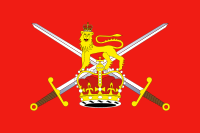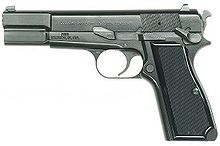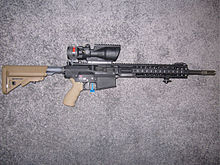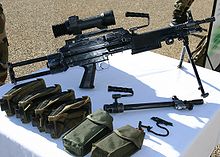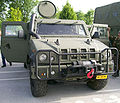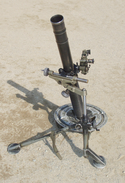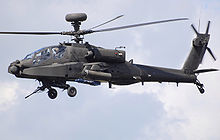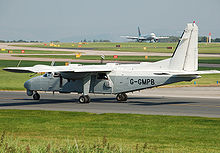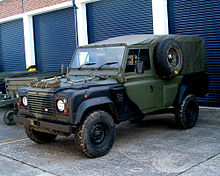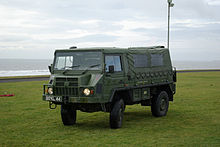- Modern equipment of the British Army
-
This article is about weapons and equipment. For details of uniforms and orders of dress, see British Army Uniform.
British Army Components British Army Territorial Army List of current regiments Structure of the British Army Administration HQ Land Forces Overseas Deployments British Forces Germany British Forces Cyprus British Forces Falkland Islands British Forces Gibraltar British Garrison Brunei Equipment British military rifles Modern Equipment History History of the British Army Timeline of the British Army Recruitment in the British Army Personnel List of senior officers Officer rank insignia Other ranks rank insignia British Army Portal Portal to other related sites This is a list of the equipment currently in use by the British Army. It includes small arms, combat vehicles, aircraft, boats, artillery and transport vehicles. The primary task of the British Army is to help defend the interests of the United Kingdom, but it can also serve as part of a North Atlantic Treaty Organisation (NATO) force, or a United Nations (UN) or any other multi-national force. To meet its commitments the equipment of the army is constantly updated and modified. To meet any shortage or requirement on operations the army can request equipment under an Urgent Operational Requirement (UOR) which supplements planned equipment programmes.[1]
Pistols
Browning Pistol (L9A1)
Main article: Browning L9A1The 9mm Browning L9A1 is the general issue pistol for self-defence. The Browning is a self-loading pistol using the standard NATO 9mm round. It has been in service since the Second World War and has proven to be a reliable, accurate and robust weapon.[2][3]
P226 SIG Pistol (L105A1, L105A2 and L106A1)
Main article: P226Variants of the P226 SIG Sauer pistol have been procured as a replacement for the Browning pistol in some units and as a UOR for use in Afghanistan. The L105A1 is the original P226, the L105A2 is the railed version and the L106A1 has an improved protective finish.[4]
Rifles and shotguns
Rifle 5.56 (L85A2)
Main articles: SA80 and Under-slung Grenade LauncherThe standard issue rifle is the (Bullpup configuration) L85A2, known popularly as the SA80. The L85A2 can be fitted with a SUSAT 4x optical sight and a LLM01 laser aiming and torch attachment. It is fed by a 30 round magazine.[5] There is also a carbine version, the L22A2, in service.[6] An Under-slung Grenade Launcher (UGL) can also be fitted to the L85 rifle. The grenade launcher is a single shot weapon with a side opening breech loading action, taking a 40mm High Explosive round. The UGL has a range of 350 meters for area targets. The sighting system is a ladder sight mounted onto the left of the weapon.[7]
Light Support Weapon (L86A2)
Main article: SA80The L86A2 Light Support Weapon (LSW) is similar to the L85 and has been in service since 1986. It has a longer barrel, a bipod and shoulder strap fitted for greater range and accuracy. Many of the weapon's parts are interchangeable with the L85, including the same 30 round magazine. The LSW is capable of producing a high rate of accurate rapid fire at ranges up to 800 meters.[5]
Sharpshooter rifle (L129A1)
A sharpshooter rifle based on Law Enforcement Internationals 7.62mm calibre LM7, was chosen by the MoD as a replacement for the AI L96 used by designated marksmen/sharpshooters.[8]
The L129A1 7.62x51mm calibre, longer range (800m), semi-automatic rifle, will replace the bolt action Accuracy International L96 in the Sharpshooter role.[9] A total of 440 Sharpshooter rifles have been bought as a £1.5m urgent operational requirement. It is the first new infantry combat rifle to be issued for more than 20 years.[10][9] The standard weapon sight is the ACOG with 400 of them on order.[11]
Heckler & Koch (HK417)
Main article: Heckler & Koch HK417The HK417 is a 7.62mm rifle that has been issued to United Kingdom specialist units.[9]
Sniper rifle (L96)
Main article: Accuracy International Arctic WarfareThe 7.62mm L96 sniper's rifle was designed to achieve a first-round hit at 600m and harassing fire out to 1100m. The Accuracy International L96 has been upgraded with a 3-12 x 50 sight and spotting scope.[12]
Long-range rifle (L115A3)
Main article: Accuracy International AWMNearly 600 of the long-range rifles have been ordered to replace the L96. The L115A3 has a scope that can magnify the target up to 25 times, a suppressor to reduce flash and noise, a folding stock and a five-round magazine. With a range of about a mile, the new weapon is being rolled out alongside the broader Sniper System Improvement programme. The L115A3 Long Range Rifle fires an 8.58mm bullet, which is heavier than the 7.62mm round of the L96, and is less likely to be deflected over extremely long ranges.[12][13]
Barrett (M82)
Main article: Barrett M82The Barrett M82 is a .50 calibre recoil-operated, semi-automatic anti-materiél rifle. The British Army uses the M82A1 version.[14]
Combat Shotgun (L128A1)
Main article: Benelli M4 Super 90The Combat Shotgun is a semi-automatic, tubular magazine fed weapon chambered for the 12 gauge cartridge. It has a capacity of eight rounds and a maximum effective range of 140 metres for solid shot and 40 metres for buckshot.[15]
Machine guns
Minimi light machine gun (L108A1/L110A1)
Main article: FN MinimiThe Minimi light machine gun (LMG) is issued to the infantry and some other units to improve their firepower over that provided by the L85 and L86. It is a 5.56x45mm NATO calibre belt-fed machine gun. It is used primarily with its bipod so it can provide a level of sustained fire not possible with the LSW with its 30-round magazine. The L110A1 is the "paratrooper" version, equipped with a shortened barrel and a collapsible stock and is now issued one per four man infantry fireteam.[16]
FN MINIMI™ 7.62 Machine Gun
In use in small numbers from 2011[17]
General-purpose machine gun (L7A2)
Main article: L7 (machine gun)The L7 General-purpose machine gun (GPMG) is the UK's version of the FN MAG. Often referred to as the 'gimpy', it can be fired from a bipod in the light role up to 800 m or from a tripod in the sustained fire role up to 1,800 m, although this falls to 1,100 m in low light conditions, as this is the range at which tracer burns out. Experienced GPMG gunners using the weapon to fire indirectly (i.e. with an arcing trajectory), are able to fire accurately out to 3000 m from the 'Sustained Fire' platform in the 'Map Predicted Fire' role. It is a 7.62x51mm NATO–calibre weapon. Other versions are mounted on various vehicles, boats and helicopters. It is also mounted as coaxial armament in combat vehicles.[18]
Heavy machine gun (L2A1)
 A GMG of the German Army
A GMG of the German Army Main article: M2 Browning machine gun
Main article: M2 Browning machine gunThe L2 Heavy Machine Gun (HMG) of the British Army is a version of the M2 Browning. It is a 12.7x99mm NATO (.50 BMG) calibre weapon. It can be mounted on a tripod or on pedestal mounts on vehicles.[19]
Heckler & Koch 40mm Grenade Machine Gun
Main article: Heckler & Koch GMGThe Heckler & Koch 40mm Grenade Machine Gun (GMG) provides a high rate of fire combined with the fragmentation effect of a mortar. The GMG is usually mounted on Jackal (MWMIK) vehicles but can also be used from tripods.[20]
Mortars
51 mm Light Mortar (L9A1)
Main article: L9A1 51 mm Light MortarThe 51 mm mortar is a light weapon which can be carried and fired by one man. Smoke, illuminating and high explosive bombs are available. The 51mm mortar, which replaced the 2" version, was due to be phased out by the use of the newer 40mm AG36 UGL (Underslung Grenade Launcher) mounted on the SA-80. However operational experience has led to the decision to replace it with a 60mm mortar[21]
60 mm Mortar (M6-895)
Main article: M6-640The Hirtenberger M6-895 60mm Mortar was procured as an UOR. It can be fired in both the direct and indirect roles at a rate of 1–12 rounds a minute and can be operated in the hand-held mode. The 640 60mm Mortar has been procured as a UOR to replace the current 51mm Mortar on current operations.[22]
81mm mortar (L16)
Main article: L16 81mm MortarThe L16A2 81mm mortar is a medium calibre weapon which is operated by a three man team. It is often vehicle-borne, and in mechanised infantry battalions is mounted and fired from an FV432 vehicle.[23]
Anti-tank weapons
MBT LAW
Main article: MBT LAWThe Main Battle Tank Light Armour Weapon (MBT LAW) is a disposable, man-portable, short range fire-and-forget anti-tank guided missile system.[24]
FGM-148 Javelin Anti-Tank Guided Missile Launcher
Main article: FGM-148 JavelinThe FGM-148 Javelin Anti-Tank Guided Missile Launcher (ATGM) has been procured as the replacement for the Milan system. It fires a missile out to ~2500 m and is capable of defeating explosive-reactive armour with a tandem High Explosive Anti Tank (HEAT) warhead. It is currently thought that the Javelin is capable of penetrating most armoured vehicles.[25]
Anti-structure weapons
Light Anti-Structures Missile (L72A9)
Main article: M72 LAWOriginally designated as the "Rocket 66mm HEAT L1A1" M72 LAW, it has been replaced in the Anti-tank role but has been modified for structure demolition purposes, the main difference is the warhead, the LASM contains about 1 kg of an enhanced blast explosive, whereas the LAW contains about a third of a kilogramme.[26]
Anti-Structures Munition
Main article: Anti-Structures MunitionThe Anti-Structures Munition is a man-portable infantry weapon specifically designed to defeat hardened structures. The contract for development of the system was awarded to Dynamit Nobel Defence in 2006. Expected in-service date is sometime in 2010.[27]
Protective equipment
Mk.6 and Mk.7 Helmet
Main article: Mk. 6 HelmetMain article: Mk. 7 HelmetThe standard helmet is the Mk.6; it is in the process of being replaced by the Mk.7. The Mk.7 helmet is equipped with a new harness that keeps the helmet more stable on the head when night vision equipment is fitted. It is also better integrated with new weapon sights, making it easier to use in a variety of fighting positions.[28]
Osprey body armour and Osprey Assault body armour
Main article: Osprey body armourSince 2006 troops in Afghanistan (and until 2009 Iraq), have been issued with Osprey body armour. This has provided much better protection than previous body armour systems.[28] The new Osprey Assault body armour, which is currently replacing Osprey, will provide the same ballistic protection, while improving the comfort of personnel on operations in Afghanistan. It has all the stopping power of the current body armour but is closer fitting, less bulky and is easier to move in. It is specifically developed to meet the British Army's requirements, using cutting edge materials and manufacturing technology.[29]
Combat vehicles
The British Army operates approx. 6,030 armoured vehicles with at-least 647 more in reserve. There are also a further 12,000 Land Rover Wolf armoured patrol vehicles in service.
Name Origin Type Number[30] Photo Notes Combat vehicles Challenger 2  United Kingdom
United KingdomMain battle tank 420 The Challenger 2 (CR2) is the British Army's battle proven Main Battle Tank. CR2 is based on the Challenger 1 that served with distinction on operations in the Gulf War and the Balkans. FV107 Scimitar  United Kingdom
United KingdomLight tank (reconnaissance) 325 Scimitar is a fast and agile light tank with the primary role of gathering information. To be replaced by 600 new light tanks. Warrior  United Kingdom
United KingdomIFV 785 
The Warrior Infantry Fighting Vehicle has the speed and performance to keep up with Challenger 2 Main Battle Tanks over the most difficult terrain, and the firepower and armour to support infantry in the assault. FV430 series and Bulldog  United Kingdom
United KingdomAPC/IFV 900 The FV 430 family of armoured vehicles entered service with the British Army in the 1960s, but regular maintenance and improvements including a new power train have enabled this old workhorse to remain in service into the 21st Century. (Approx. 500 more in storage) CVR(T) Family  United Kingdom
United KingdomAPC and Recconnaisance 1,179 As an Armoured Personnel Carrier (APC), it can carry four men in addition to the crew of three. It is used to carry small specialised groups such as reconnaissance teams, air defence sections and mortar fire controllers. Mastiff Cougar 6x6 MPV  United States
United StatesIFV 304 Mastiff 2 is a heavily armoured, 6 x 6 wheel-drive patrol vehicle which can carry eight people, plus two crew. It began operational duties in June 2009. Ridgback Cougar 4x4 MPV  United States
United StatesIFV 155 More agile than the Mastiff, the Ridgback, though very similar, is nearly two metres shorter but, crucially, a metre slimmer than its big brother, which allows troops greater access and mobility within built-up environments. Wolfhound 6x6 MPV  United States
United StatesIFV 73 The Wolfhound is a tactical support variant of the Mastiff, which will give support troops increased protection in high-threat areas. It has a larger load-carrying ability, and will mainly operate in the logistical role, moving ammunition for Light Guns, or carrying Bulky Stores. TPz Fuchs  West Germany
West GermanyAPC and Biological warfare 11 The Fuchs vehicles were initially gifted to the UK for the first Gulf War, since when they have been upgraded to be one of the most technologically advanced vehicles of their type in the world. They are manned by a crew of four, Commander, Driver and two Operators. The Fuchs were the first British vehicles into Iraq of the main ground force during the first Gulf War. The vehicle is fully amphibious with a speed through water of 10 kts. It forms part of the armoured arm of the CBRN Regiment which facilitates freedom of movement while the Land Forces advance. Viking BVS10  United Kingdom
United KingdomAPC and IFV 161 The VIKING BVS10 All Terrain Vehicle (Protected) ATV(P) is the third generation of articulated vehicles produced by BAE Systems Hagglunds of Sweden. Land Rover Wolf
Land Rover Snatch United Kingdom
United KingdomPatrol 12,000[31]
574The Land Rover Wolf is the British Army's light armoured and patrol combat vehicle. Some 12,000 are in service in the British Army.[31]
The 577 Land Rover Snatch 2s in the British Army are a Protected Patrol Vehicle, based on the Land Rover Heavy Duty Chassis. This upgraded vehicle includes armour for troops on the frontline facing IEDs and Mines.Vector Pinzgauer  United Kingdom
United KingdomLight APC and Patrol 179 The Vector provides good protection and, importantly, increased mobility and capacity compared to the Snatch Landrover, which makes it very suitable for the rugged terrain and long patrol distances in Afghanistan. Supacat "Jackal" MWMIK  United Kingdom
United KingdomTactical Support 270 Used for reconnaissance, rapid assault, fire support and convoy protection, the Jackal has the capacity to support itself and its crew over 800 km. It has a maximum speed of 80 mph (129 km/h) on roads and weighs seven tonnes.[32] Iveco "Panther" CLV.  Italy
ItalyCommand and Liaison 412 The Army received the Panther Command and Liaison Vehicle in summer 2009, replacing some of the in-service CVR(T)s, TUMs, Saxon and FV432 vehicles. Husky International MXT-MV  United States
United StatesProtected Support Combat Vehicle 236 The Husky is a protected support vehicle providing commanders with a highly mobile and flexible load carrying vehicle. It is equipped with a machine gun. Force Protection "Foxhound"  United Kingdom
United KingdomLight Protected Patrol Vehicle 300 (Approx.) The Foxhound is a new armoured patrol vehicle that is intended to replace the current Land Rover Snatch. It design is specifically suited to providing protection from Improvised Explosive Devices (IED)s and so-called 'roadside bombs'. The vehicle is due to start operations by 2011.[33] Artillery and air defence
The British Army operates approx. 3,162 artillery pieces and mortars.
Name Origin Type Number[34][35] Photo Notes Artillery AS90  United Kingdom
United KingdomSelf-propelled 155mm howitzer 166[36] The AS90 is a 155mm self-propelled gun that equips six Field Regiments of the Royal Horse Artillery and Royal Artillery. L118 Light Gun  United Kingdom
United KingdomTowed 105mm howitzer 138 The 105 mm Light Gun is used by the Parachute and Commando Field Artillery Regiments of the British Army. MLRS  United States
United StatesRocket artillery 42 The Guided Multiple Launch Rocket System (GMLRS), nicknamed the '70 km Sniper', provides pinpoint accuracy, delivering a 200 lb high explosive warhead to its target. It has twice the range of other artillery systems used by the British Army. Rapier FSC Missile System  United Kingdom
United KingdomSurface-to-air missile 24 Rapier Field Standard C is a technologically advanced Short Range Air Defence System (SHORAD) and is in service with the Royal Artillery. Starstreak HVM  United Kingdom
United KingdomHigh Velocity Missile 229 The Starstreak HVM (High Velocity Missile) is designed to counter threats from very high performance, low-flying aircraft and fast 'pop up' strikes by helicopters. L16 81mm Mortar
L9A1 51 mm Light Mortar
M6-640 United Kingdom
United KingdomMortar 470
2,093
?The mortar is a Battlegroup level indirect fire weapon which is capable of providing accurate High Explosive, smoke and illuminating rounds out to a maximum range of 5,650m. The Hirtenberger M6-895 60 mm Mortar was procured as an Urgent Operational Requirement (UOR). It can be fired in both the direct and indirect fire role at a rate of 1–12 rounds a minute and can be operated in the hand held mode. The 640 60 mm Mortar has been procured as a UOR to replace the current 51 mm Mortar on current operations.[22] CBRN equipment
Main articles: TPz Fuchs and Integrated Biological Detection SystemFuchs NBC reconnaissance vehicle
The Fuchs Nuclear, Biological and Chemical Reconnaissance Vehicle is one of the most technologically advanced vehicles of its type in the world.[37]
Integrated Biological Detection System
The Integrated Biological Detection System (IBDS) provides an enhanced and automated NBC detection system. The IBDS is installed in a container which can be mounted on a vehicle or transported by either fixed or rotary wing aircraft. The IBDS provides the commander in the field with early warning of a chemical or biological attack.[37]
Engineer equipment
The British Army operates approx. 621+ engineering vehicles.
Name Origin Type Number[34] Photo Notes Engineering equipment CRARRV Challenger 2  United Kingdom
United KingdomChallenger Armoured Repair and Recovery Vehicle 81 The Challenger Armoured Repair and Recovery Vehicle (CRARRV) is a highly evolved armoured vehicle designed to recover and repair damaged tanks on the battlefield. FV434  United Kingdom
United KingdomArmoured Repair Vehicle 50? Unknown FV434 is the Armoured Repair Vehicle variant of the British Army's FV430 series of armoured fighting vehicles. Introduced in the 1960s and is operated by the Royal Electrical and Mechanical Engineers (REME). FV106 Samson  United Kingdom
United KingdomArmoured Recovery Vehicle 120 Armoured Recovery Vehicle variant of the CVR(T) range of combat vehicles. Capable of recovering up to 12 Tonnes of vehicle. FV512 MCRV Warrior IFV  United Kingdom
United KingdomMechanised Combat Repair Vehicle 110 Variant of Warrior Fighting Vehicle. Equipped with a winch for recovery of other armoured and soft skinned vehicles of a similar and lesser weight. FV513 MRV(R) Warrior IFV  United Kingdom
United KingdomMechanised Combat Recovery Vehicle (Repair) 67 Variant of Warrior Fighting Vehicle. Equipped with a winch for recovery of other armoured and soft skinned vehicles of a similar and lesser weight. Also fitted with a 6.5 tonne crane to aid in the quick repair of recovered equipment. Titan AVLB Challenger 2  United Kingdom
United KingdomArmoured Vehicle Launched Bridge 33 Titan is a new armoured engineer vehicle designed to enable troops and vehicles to cross gaps of up to 60 metres by laying a selection of close support bridges. Along with Trojan it gives a common heavy armour fleet based on the Challenger 2 chassis. Trojan (vehicle)  United Kingdom
United KingdomMinefield Breaching vehicle 33 Trojan is an armoured engineer vehicle designed to open routes through complex battlefield obstacles and clear a path through minefields. Shielder minelaying system  United Kingdom
United KingdomAnti-tank Mine layer 29 The Shielder Anti-Tank System gives commanders the facility to create anti-tank barriers quickly and effectively. Python Minefield Breaching System  United Kingdom
United KingdomMinefield Breaching System 30? Unknown Python is a highly effective minefield breaching system which has been successfully tested with the British Army. M3 Amphibious Bridge  Germany
GermanySelf-propelled Amphibious Bridging vehicle 50? Unknown The M3 Amphibious Rig can be driven into a river and used as a ferry or, when a number are joined together from bank to bank, as a bridge, capable of taking vehicles as heavy as the Challenger 2. Buffalo  United Kingdom/
United Kingdom/ United States
United StatesMine protected Clearance Vehicle 18 The Buffalo mine protected vehicle is a wheeled armored vehicle built by Force Protection Inc. It was designed based on the successful South African Casspir mine-protected vehicle.[38] Dragon Runner
Main article: Dragon RunnerDragon Runner is a lightweight, man-portable robot capable of detecting a variety of explosive devices without putting the operator in danger.[39]
Aircraft
The Army Air Corps operates approximately 218 aircraft, of which 12 are fixed wing and the rest are helicopters. The British Army also operates a number of UAVs used by the Royal Artillery.
Helicopters
The Westland Apache was designed to hunt and destroy tanks and can operate in all weathers, day or night. It carries a mix of weapons including rockets, Hellfire missiles and a 30mm chain gun.[40]
The Bell 212 is used in the jungle areas of Belize and Brunei.[40]
The Westland Lynx is a battlefield utility helicopter although it has been used for both anti–tank and reconnaissance operations. The addition of door gunners has allowed Lynx to operate in the very close air support role.[40]
The Eurocopter Dauphin is used in support of United Kingdom Special Forces.[41]
The Westland Gazelle is a small single-engined helicopter primarily used for observation and reconnaissance.[40] It is an older aircraft type with limited capability and is not deployed on combat roles. Under current plans the out of service date for the Gazelle is 2012.[42]
The Eurocopter Squirrel is the basic training helicopter for the Army.[40]
Fixed wing
The Britten-Norman Islander and Defender are light aircraft used for airborne reconnaissance and command. They have a range of 380 nautical miles and can carry two crew and six passengers.[40]
Unmanned aerial vehicles
The Desert Hawk is a Mini Unmanned Air Vehicle (MUAV). It Provides day and night coverage at down to company level. It has an extremely good record proven by supporting both 16 Air Assault Brigade and 3 Commando Brigade in Afghanistan. It has a flight time of approximately one hour, and can fly anywhere within a 10 kilometre radius of its ground control station[43]
The Watchkeeper WK450 is a larger more advanced aircraft, with twin payloads, that can operate in all weathers and can take off and land automatically.[43] For long endurance missions it can be fitted with two 50 litre auxiliary fuel tanks, but it has a typical endurance of 17 hours. WK450 has a maximum payload capacity of 150 kilogrammes. which will include day and night sensors, a flir, a zoom television camera, a laser range finder and target designator and a combined synthetic aperture radar and ground moving target indicator.[44]
B (unarmoured) vehicles
Land Rover
Numerous variants of the Land Rover are used such as the Land Rover Wolf Truck Utility Light and Medium (Higher Specification) (designated TUL-HS and TUM-HS), the Land Rover Defender Truck Utility Light and Medium (designated TUL and TUM) and a version fitted as a Battlefield Ambulance, using the Land Rover Defender 127" chassis.[45]
Quad bikes
Quad bikes are used for light transport for things such as mortars, ammunition and supplies in general.[46]
DROPS
The Demountable Rack Offload and Pickup System (DROPS) is a standard pallet and rack system used by the British Army. Vehicles equipped for the system include the Leyland DAF and Foden EKF 6 x 8 Improved Medium Mobility Load Carriers.[45]
High-mobility vehicles
Main articles: Pinzgauer High Mobility All-Terrain Vehicle and All Terrain Mobility PlatformThe Pinzgauer 716M is a four-wheel–drive transporter used by the Royal Artillery to tow the L118 Light gun and the Rapier missile system. It is also used as a small logistics vehicle; the armoured version is known as the Vector.[45]
The All Terrain Mobility Platform (ATMP) is a versatile, lightweight load-carrying six-wheeled vehicle used by airborne and air-mobile battalions.[45]
Springer All-Terrain Vehicle
Designed as a light-role load carriage platform, the Springer is based on the US-made Tomcar. The 4 x 2 vehicle can self-load a 1t pallet. Each vehicle is equipped with an 8,000 lb self-recovery winch and sand ladders, which act as loading ramps for a cargo pallet.[47]
Motorcycles
Harley Davidson MT350E and Honda R250 motorcycles are used by dispatch riders and for a variety of liaison and traffic control tasks.[45]
Heavy transport
The Oshkosh Tank Transporter or Heavy Equipment Transporter (Oshkosh HET 1070F) is capable of carrying a 70-tonne main battle tank or of loading one that has been immobilised. The army also uses a number of MAN SX and MAN HX logistic vehicles with varying capacities, including special variants such as a Unit Support Tanker, and a Recovery Vehicle.[45][48]
Communications equipment
Main articles: Bowman (communications system), Personal Role Radio, and Skynet (satellites)BOWMAN
Bowman is the tactical C4I system being issued to British forces to replace the Clansman.
Personal Role Radio
Personal Role Radio (PRR) is distributed to every member of an eight-strong infantry section.[49]
Skynet
Skynet is a family of military satellites, which provide strategic communication services to the three branches of the British Armed Forces and to NATO forces engaged in coalition tasks.[50]
Landing craft and assault boats
 Ramped Craft Logistic L106 at Akrotiri, Cyprus
Ramped Craft Logistic L106 at Akrotiri, Cyprus
MK 6 Assault boat
The Mk 6 Assault Boat is a glass reinforced plastic boat, operated by the Royal Engineers which can be carried by four men. It is designed to carry up to 10 fully equipped troops or 1,043 kg of stores, it also makes a useful light ferry when fitted with an outboard motor.[51]
Rigid Raider
The Rigid Raider is a series of rigid hulled raiding craft, operated mainly by the Royal Engineers and Royal Marines, but also by the Royal Logistic Corps. The Mk 3 craft is capable of 30 knots and can be beached during assaults. It is also used in support of bridging operations.
Combat Support Boat
The Combat Support Boat (CSB) is a powerful, versatile craft designed to support both bridging and amphibious operations. Powered by water jet propulsion it has a shallow draught. It is generally operated by the Royal Engineers as a general-purpose boat in support of diving operations, ship-to-shore re-supply and inland riverine patrols.[51] It is also operated by the Royal Marines.
Ramped Craft Logistic
Ramped Craft Logistic (RCL) is operated by the Royal Logistic Corps for amphibious operations and is designed to deliver men and materiél onto beaches.[51]
Infantry section equipment
The infantry section normally has two 4-man infantry fire teams. On operations each fire team can be equipped with the following:[52]
Weapons
- 1 x L85A2
- 1 x L85A2 with UGL
- 1 x Minimi light machine gun
- 1 x L129A1 DMR
- 1 x 84mm Antitank Weapon
- 1 x Light Anti Structure Munition
- 4 x White Phosphorus smoke grenades
- 8 x high explosive grenades
- 4 x smoke grenades
Vision systems
- 3 x Sight Unit Small Arms, Trilux (SUSAT)
- 1 x Advanced Combat Optical Gunsight (ACOG) to be used with the L129A1 DMR
- 2 x image intensified Common Weapon Sights
- 1 x TAM 14 small Thermal Imaging System
- 1 x Head Mounted Night Vision System (HNVS)
- 2 x VIPER 2+ thermal imaging weapon sight
- 2 x commanders target locating system (CTLS)
Communications equipment
Future equipment
Future Lynx Wildcat
The Lynx Wildcat will be a fleet of 62 new light helicopters for the Army and Royal Navy from 2014 and 2015 respectively. The Army variant of the Lynx Wildcat will be used for reconnaissance, command and control, transportation of troops and materiél and the provision of force protection. With new Rolls-Royce CTS800-4N engines it will be significantly more powerful than the current Lynx, enabling it to operate in extreme hot conditions and high altitudes.[53]
Future Integrated Soldier Technology
The Future Integrated Soldier Technology is a suite of equipment capable of enhancing an infantryman's effectiveness as part of the Future Soldier programme.[54]
Future Rapid Effect System
The Future Rapid Effect System is a planned family of medium-weight armoured vehicles intended to replace the Saxon, FV432 and CVR(T) series of vehicles.[55]
Support vehicle
A new unarmoured Support vehicle, is currently being introduced into service. There will be 6,928 cargo vehicles including unit support tankers, 288 recovery vehicles and 69 recovery trailers with the deployment planned for 2014.[45]
References
- ^ "Urgent Operational Requirements (UOR)". Ministry of Defence (United Kingdom). http://www.mod.uk/DefenceInternet/FactSheets/UrgentOperationalRequirementsuor.htm. Retrieved 2010-02-07.
- ^ The Wire. Royal Signals. June 2009. p. 10.
- ^ "Browning 9mm Pistol". Ministry of Defence (United Kingdom). http://www.raf.mod.uk/rafregiment/forceprotection/browning9mmpistol.cfm. Retrieved 2009-02-07.
- ^ "UK forces' light weaponry showcased at MOD HQ". Ministry of Defence (United Kingdom). http://www.mod.uk/DefenceInternet/DefenceNews/EquipmentAndLogistics/UkForcesLightWeaponryShowcasedAtModHq.htm. Retrieved 2010-01-29.
- ^ a b "SA80 A2 L85 Individual Weapon". Ministry of Defence (United Kingdom). http://www.army.mod.uk/equipment/support-weapons/1458.aspx. Retrieved 2010-01-28.
- ^ "Armed Forces Equipment". Parliament of the United Kingdom. http://www.theyworkforyou.com/wrans/?id=2009-11-10b.297887.h&s=browning+pistol#g297887.r0. Retrieved 2010-02-08.
- ^ "Underslung Grenade Launcher (UGL)". Ministry of Defence (United Kingdom). http://www.raf.mod.uk/rafregiment/forceprotection/underslunggrenadelauncherugl.cfm. Retrieved 2010-02-07.
- ^ "L129A1 (LM7)". Discovermilitary.com. 2010-08-09. http://discovermilitary.com/weapons/sniper-rifles/l129a1-lm7/. Retrieved 2010-08-09.
- ^ a b c "UK selects 7.62 mm Sharpshooter weapon for Afghan ops". Jane's Information Group. http://www.janes.com/news/defence/land/jdw/jdw091229_1_n.shtml. Retrieved 2009-12-29.
- ^ "L129A1 Sharpshooter rifle". Ministry of Defence (United Kingdom). http://www.mod.uk/DefenceInternet/DefenceNews/EquipmentAndLogistics/NewSharpshooterRifleForTroopsInAfghanistan.htm. Retrieved 2010-01-28.
- ^ "ACOG Bible references to be removed". Defence Management. 2010-01-22. http://www.defencemanagement.com/news_story.asp?id=11942. Retrieved 2010-04-19.
- ^ a b "L96 Sniper Rifle and L115A3 Long Range Rifle". Ministry of Defence (United Kingdom). http://www.mod.uk/DefenceInternet/FactSheets/L96SniperRifleAndL115a3LongRangeRifle.htm. Retrieved 2010-01-28.
- ^ "L115A3 Long Range Rifle". Ministry of Defence (United Kingdom). http://www.army.mod.uk/equipment/support-weapons/1459.aspx. Retrieved 2010-01-28.
- ^ Gander, Terry (2006). Jane's Infantry Weapons 2006-2007. Jane's Information Group. p. 22. ISBN 0710627556.
- ^ "Combat Shotgun". Ministry of Defence (United Kingdom). http://www.army.mod.uk/equipment/support-weapons/17927.aspx. Retrieved 2010-01-28.
- ^ "Light Machine Gun (LMG)". Ministry of Defence (United Kingdom). http://www.army.mod.uk/equipment/support-weapons/1462.aspx. Retrieved 2010-01-28.
- ^ "FN MINIMI™ 7.62 Machine Gun Selected by British Military". http://www.army-technology.com/contractors/machine_guns/fnherstal/press32.html.
- ^ "General Purpose Machine Gun". Ministry of Defence (United Kingdom). http://www.army.mod.uk/equipment/support-weapons/1463.aspx. Retrieved 2010-01-28.
- ^ "Heavy Machine Gun (HMG)". Ministry of Defence (United Kingdom). http://www.army.mod.uk/equipment/support-weapons/1464.aspx. Retrieved 2010-01-28.
- ^ "Grenade Machine Gun". Ministry of Defence (United Kingdom). http://www.army.mod.uk/equipment/support-weapons/1467.aspx. Retrieved 2010-01-28.
- ^ "Modernizing Fire Support at AUSA 2007". http://www.defense-update.com/events/2007/summary/ausa07fires.htm. "The British Army already decided to phase out its 51mm tubes in favour of 60mm mortars."
- ^ a b "British Army Vehicles and Equipment". MoD. http://www.army.mod.uk/documents/general/285986_ARMY_VEHICLESEQUIPMENT_V12.PDF_web.pdf.
- ^ "81mm Mortar". Ministry of Defence (United Kingdom). http://www.army.mod.uk/equipment/support-weapons/1469.aspx. Retrieved 2010-01-28.
- ^ "MBT LAW Light Anti-Tank Weapon". Army technology. http://www.army-technology.com/projects/mbt_law/. Retrieved 2010-01-28.
- ^ "Javelin Medium Range Anti-tank Guided Weapon". Ministry of Defence (United Kingdom). http://www.army.mod.uk/equipment/support-weapons/1471.aspx. Retrieved 2010-01-28.
- ^ "LASM". Ministry of Defence (United Kingdom). http://www.army.mod.uk/equipment/support-weapons/1465.aspx. Retrieved 2010-01-28.
- ^ "International Guns, Missiles and Rockets Team". Ministry of Defence (United Kingdom). http://www.mod.uk/DefenceInternet/MicroSite/DES/OurTeams/WeaponsTeams/InternationalGunsMissilesAndRocketsTeam.htm. Retrieved 2010-01-28.
- ^ a b "New helmets and armour for troops in Afghanistan". Ministry of Defence (United Kingdom). http://www.mod.uk/DefenceInternet/DefenceNews/EquipmentAndLogistics/NewHelmetsAndArmourForTroopsInAfghanistan.htm. Retrieved 2010-02-05.
- ^ "Personal Armour". British Army. http://www.army.mod.uk/equipment/personal/1456.aspx. Retrieved 2010-03-09.
- ^ http://www.publications.parliament.uk/pa/cm201011/cmhansrd/cm110127/text/110127w0004.htm
- ^ a b Armedforces.co.uk
- ^ Mod.uk
- ^ "Ocelot revealed as Snatch Land Rover replacement". BBC News. 2010-09-22. http://www.bbc.co.uk/news/uk-11388724.
- ^ a b Publications.parliament.uk
- ^ Armedforces.co.uk
- ^ http://www.publications.parliament.uk/pa/cm201011/cmhansrd/cm110127/text/110127w0004.htm
- ^ a b "Fuchs Reconnaissance Vehicle". Ministry of Defence (United Kingdom). http://www.army.mod.uk/equipment/defence/1542.aspx. Retrieved 2010-02-02.
- ^ Buffalo (mine protected vehicle)
- ^ "Dragon Runner bomb disposal robot". Ministry of Defence (United Kingdom). http://www.army.mod.uk/equipment/engineering/18825.aspx. Retrieved 2010-02-03.
- ^ a b c d e f "Aircraft". Ministry of Defence (United Kingdom). http://www.army.mod.uk/equipment/aircraft/default.aspx. Retrieved 2010-February-2.
- ^ Tim Ripley (10 December 2008). "UK Army Air Corps received Dauphins". Janes Defence Weekly, Vol. 45, Issue 50: 10.
- ^ "Gazelle Helicopters". United Kingdom parliament. http://www.theyworkforyou.com/wrans/?id=2008-07-07g.216182.h. Retrieved 2010-February-7.
- ^ a b "Unmanned Aerial Vehicles". Ministry of Defence (United Kingdom). http://www.army.mod.uk/equipment/aircraft/1535.aspx. Retrieved 2010-February-2.
- ^ "Watchkeeper Tactical UAV System". Army Technology. http://www.army-technology.com/projects/watchkeeper/. Retrieved 2010-February-7.
- ^ a b c d e f g "General Support Vehicles (GSV) Project Team". Ministry of Defence (United Kingdom). http://www.mod.uk/DefenceInternet/MicroSite/DES/OurTeams/LandTeams/GeneralSupportVehiclesgsvProjectTeam.htm. Retrieved 2010-02-05.
- ^ "Quad bikes". Ministry of Defence. http://www.army.mod.uk/equipment/engineering/16513.aspx. Retrieved 10 November 2011.
- ^ "Springer All-Terrain Vehicle, United Kingdom". Army Technology. http://www.army-technology.com/projects/springer-all-terrain/. Retrieved 2010-02-07.
- ^ "IDEX 2009 - Heavy-duty recovery trucks from MAN". http://www.janes.com/events/exhibitions/idex2009/sections/daily/day4/heavyduty-recovery-trucks.shtml. Retrieved 2010-10-19.
- ^ a b "Personal Role Radio". Ministry of Defence (United Kingdom). http://www.army.mod.uk/equipment/personal/1454.aspx. Retrieved 2010-01-28.
- ^ "Skynet 5 Satellite Communications". Ministry of Defence (United Kingdom). http://www.army.mod.uk/equipment/communication/1528.aspx. Retrieved 2010-01-28.
- ^ a b c "Landing Craft & Assault Boats". Ministry of Defence (United Kingdom). http://www.army.mod.uk/equipment/boats/default.aspx. Retrieved 2010-02-02.
- ^ Major General WH Moore CBE (Winter 2008). "The UOR Advantage". Defence Management Journal: 79.
- ^ "AW159 Lynx Wildcat". Ministry of Defence (United Kingdom). http://www.army.mod.uk/equipment/aircraft/11128.aspx. Retrieved 2010-02-07.
- ^ "New targeting technology for troops in Afghanistan". Ministry of Defence (United Kingdom). http://www.mod.uk/DefenceInternet/DefenceNews/EquipmentAndLogistics/NewTargetingTechnologyForTroopsInAfghanistan.htm. Retrieved 2010-02-05.
- ^ "Design selected for future armoured vehicle for British Army". Ministry of Defence (United Kingdom). http://www.mod.uk/DefenceInternet/DefenceNews/EquipmentAndLogistics/DesignSelectedForFutureArmouredVehicleForBritishArmyfres.htm. Retrieved 2010-02-05.
External links
- British Army equipment - official Ministry of Defence (United Kingdom) website.
- Equipment on the British Army Rumour Service
- Defence Suppliers Directory - defence industry database.
- British Army regiments and weapons
Current UK individual weapons and cartridges Pistols Assault rifles
carbines
Designated marksman riflesSniper rifles L96A1, L118A1 • L115A1, L115A3 • L82A1 • L121A1 • Arctic Warfare CovertSubmachine guns Shotguns L74A1 • L128A1Machine guns Grenade
non-lethal launchersRockets Missiles Mortars Modern cartridges used Military equipment of Europe Sovereign
states- Albania
- Andorra
- Armenia
- Austria
- Azerbaijan
- Belarus
- Belgium
- Bosnia and Herzegovina
- Bulgaria
- Croatia
- Cyprus
- Czech Republic
- Denmark
- Estonia
- Finland
- France
- Georgia
- Germany
- Greece
- Hungary
- Iceland
- Ireland
- Italy
- Kazakhstan
- Latvia
- Liechtenstein
- Lithuania
- Luxembourg
- Macedonia
- Malta
- Moldova
- Monaco
- Montenegro
- Netherlands
- Norway
- Poland
- Portugal
- Romania
- Russia
- San Marino
- Serbia
- Slovakia
- Slovenia
- Spain
- Sweden
- Switzerland
- Turkey
- Ukraine
- United Kingdom
States with limited
recognition- Abkhazia
- Kosovo
- Nagorno-Karabakh
- Northern Cyprus
- South Ossetia
- Transnistria
Other entities Categories:- British Army equipment
- Modern military equipment of the United Kingdom
- British military uniforms
- British Army lists
- British Armed Forces
Wikimedia Foundation. 2010.

